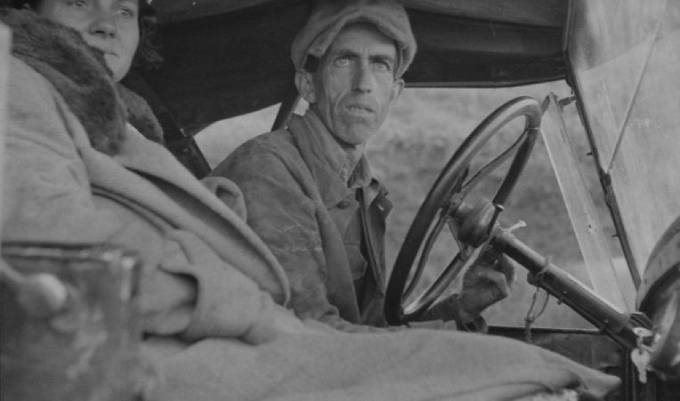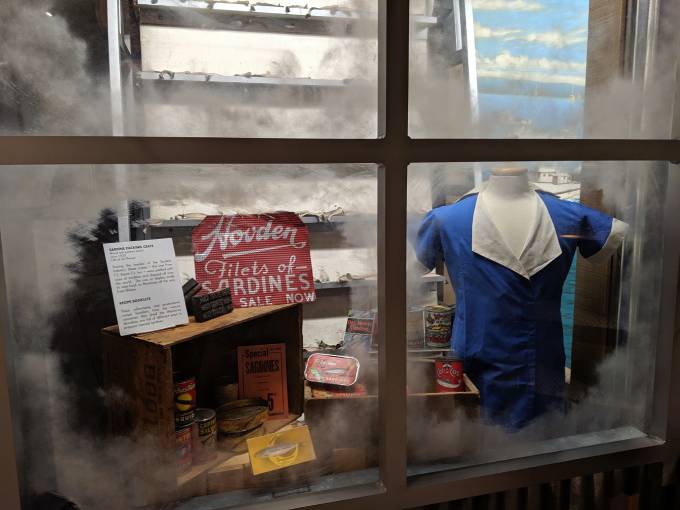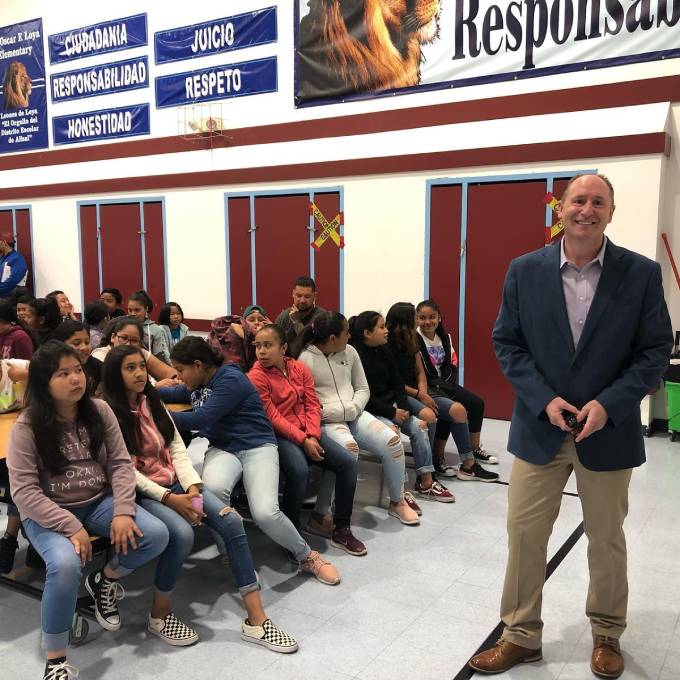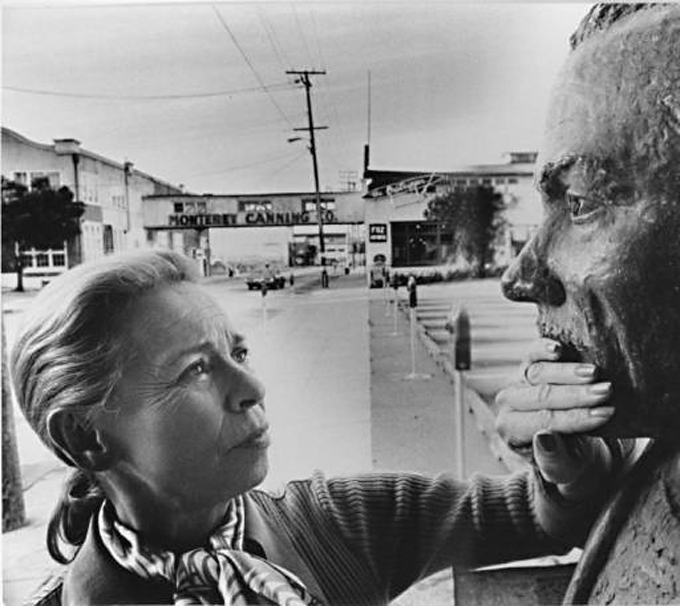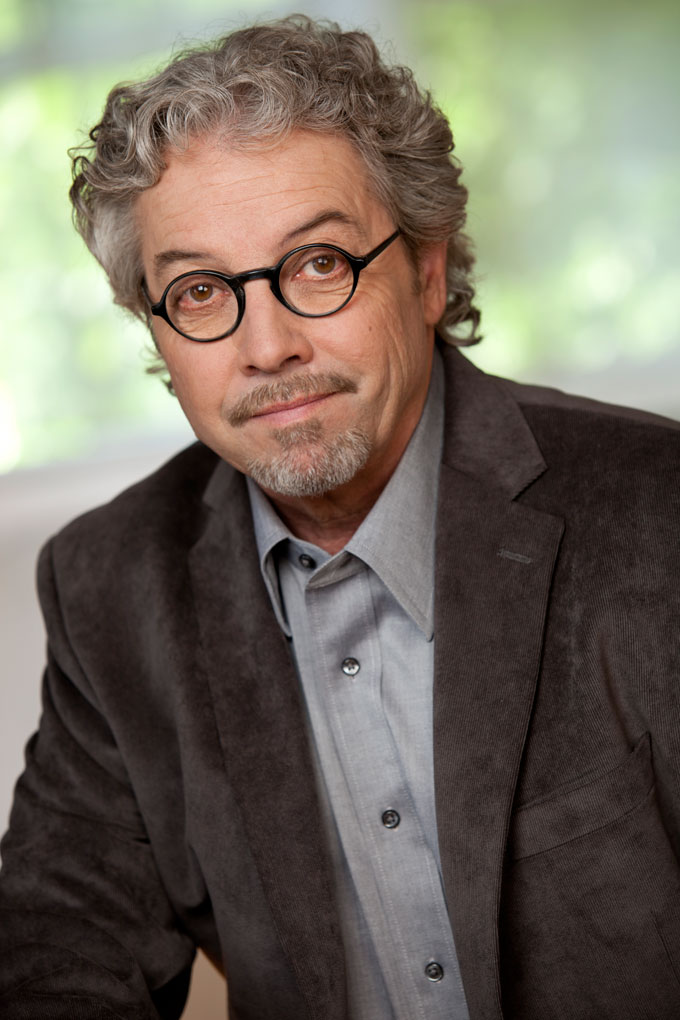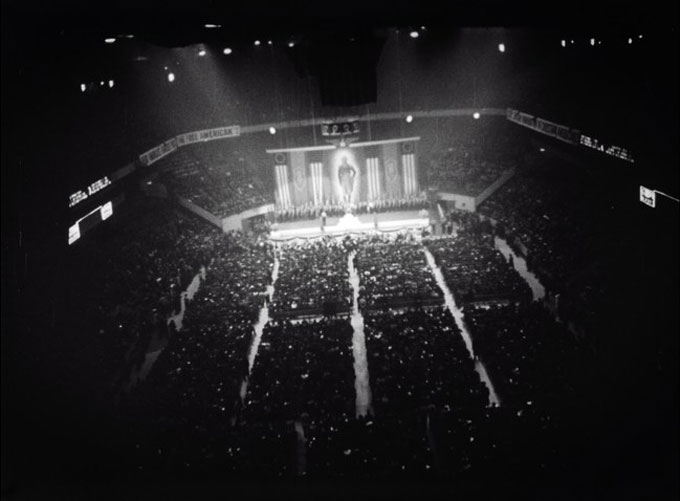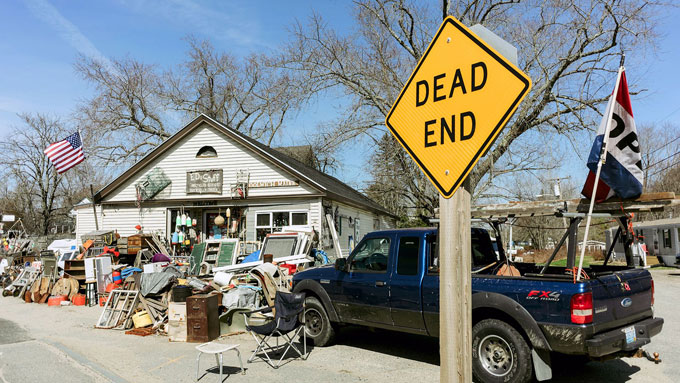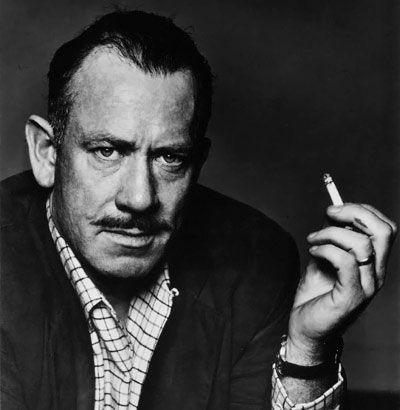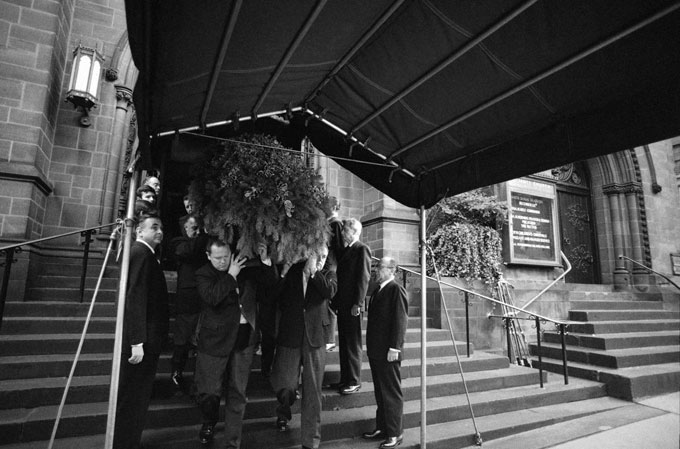A new report entitled “’The Grapes of Wrath,’ coronavirus edition” cites John Steinbeck’s classic to predict possible effects of the COVID-19 crisis on life in America if the current pandemic results in a second Great Depression. Writing in the March 28 edition of City & State New York, Zach Williams says that “An economic downturn, state border checkpoints and increasing desperation among people across the country suggest that as time goes by the story of coronavirus will only become more like a John Steinbeck novel whose ending no one can yet know.” Comparing New Yorkers today to the migrants in Steinbeck’s masterpiece, the online magazine article—illustrated with this photograph by Dorothea Lange—reminds contemporary readers that California subjected the “bum brigade” streaming into the state from Oklahoma and elsewhere to a Great Depression version of border-crossing stop-and-frisk. “After the American Civil Liberties Union filed suit in federal court,” writes one source quoted in the piece, “the ‘bum blockade’ ended. But the ‘anti-Okie’ sentiment continued.” Today, says Williams, “it is New Yorkers who are facing the wrath of their fellow Americans.”
Steinbeck Center in Salinas, California Celebrates Women Workers of Cannery Row
The history, lives, and contribution of female canning workers during Cannery Row’s 20th century sardine boom will be celebrated in a special exhibit at the National Steinbeck Center in Salinas, California, starting November 15-16, 2019. Created in honor of the 75th anniversary of John Steinbeck’s 1945 novel Cannery Row, the exhibit features a donated collection from the Monterey History & Maritime Museum that includes cans and labels from the assembly line, union booklets, and cannery workers’ uniforms, along with an opening event screening of the 1973 cinematic poem Street of the Sardine, by the French physician-filmmaker Eva Lothar. “Cannery Girls” runs through the second week of January 2020.
Photo from Cannery Row workers exhibit courtesy National Steinbeck Center.
Steinbeck at War Brings Wrobel to Salinas, California
David M. Wrobel—Dean of the College of Arts and Sciences at Oklahoma University, President-Elect of the Western History Association, and Visiting Scholar at the National Steinbeck Center—recently spent a busy week in Salinas, California speaking to audiences young and not-so-young about John Steinbeck’s war reporting in World War II and, 20 years later, in Vietnam. On September 5 Wrobel explored the question of the century—“Who was John Steinbeck?—with an energetic group of fifth and sixth graders from schools named for famous figures, including John Steinbeck, Cesar Chavez, and Oscar Loya, the former superintendent of schools for the district settled by “Okies” and others, east of Salinas. On September 6 he met with John Wood’s English class at Everett Alvarez High School, then led discussion of Steinbeck’s controversial career as a war correspondent at the National Steinbeck Center—a presentation which he repeated the following day at the Monterey Public Library. Wrobel holds the Merrick Chair in Western American History at the University of Oklahoma, but he discovered Steinbeck as a British school boy growing up in London council housing. Though an Englishman explaining Steinbeck to Californians might sound a bit like bringing coals to Newcastle, Wrobel’s enthusiasm is infectious, as shown in this photo of his reception by American school children assembled for the purpose in Steinbeck’s home town.
Exhibit, Conference Show Steinbeck is in Good Hands
The local link between Ludwig van Beethoven and John Steinbeck, a man who loved Broadway but preferred Bach, gave minds at San Jose State University—where the Martha Heasley Cox Center for Steinbeck Studies shares space with the Ira F. Brilliant Center for Beethoven Studies—the bright idea for The Art of Biography, an exhibit of images and objects from the two collections that runs through July 6, 2019 on the fifth floor of the Martin Luther King, Jr. Library. Timed to coincide with the 2019 Steinbeck conference, held May 1-3, the exhibit’s Steinbeck content was created by Alexandra Mezza and Allison Galbreath, graduating students in the MFA creative writing program directed by Nick Taylor, who also serves as director of the Steinbeck center.
The local link between Ludwig van Beethoven and John Steinbeck gave San Jose State University the idea for an exhibit of images and objects from the two collections.
Like this exhibit photo of Elaine Steinbeck, taken at Cannery Row in 1975, the 2019 conference field was dominated by women with a special touch for John Steinbeck. Speakers included Mary Papazian, the Milton scholar who became San Jose State University’s president since the last Steinbeck conference was held three years ago; Noelle Brada-Williams, the new chair of the university’s English department; Susan Shillinglaw, English professor and author of the artful biography, Carol and John Steinbeck: Portrait of a Marriage; Marisa Plumb, also of the English department; Barbara A. Heavilin, professor emeritus at Taylor University and editor-in-chief of Steinbeck Review; Mimi Gladstein, the University of Texas, El Paso, superstar who writes about Steinbeck, Hemingway, and Faulkner’s women; Cecilia Donohue, a retired professor of English at Madonna University; Elisabeth Bayley, who teaches at Loyola University in Chicago; Aya Kubota, a professor at Japan’s Bunka Gakuen University; Lori Newcomb, a teacher at Wayne State College; Naama Cohen of Tel Aviv University; Danica Cerce, a member of the faculty of the University of Ljubljana in Slovenia; Debra Cumberland, a teacher at Winona State University; Robin Provey, a graduate student at Western Connecticut State University; Jennifer Ren, an entering law student at the University of Houston; and Audry Lynch, the veteran educator from Boston who had the unusual experience of interviewing each of Steinbeck’s three wives in California.
Like the exhibit photo of Elaine Steinbeck taken in 1975, the 2019 conference field was dominated by women with a special touch for John Steinbeck.
Women also filled the stage for after-hour attractions during the conference. Three 2018-19 Steinbeck Fellows in Creative Writing at San Jose State University—Katie M. Flynn, Kirin Khan, and Christine Vines—read from their fiction on opening night. When the formal program closed on Friday, 20 of 50 conference attendees boarded the bus for Salinas, where Susan Shillinglaw led a look-and-listen tour that included the Red Pony Ranch, the Steinbeck House, and the National Steinbeck Center, where Michele Speich—a nonprofit professional from Monterey—recently succeeded Shillinglaw as the Salinas organization’s executive director. Steinbeck House dinner was served by members of the Valley Guild, the group of mostly female volunteers who bought the home in the 1970s and pay the bills by running the restaurant and encouraging donations. If Martha Heasley Cox had such women in mind for the future of John Steinbeck’s legacy when she started the center that bears her name, also in the 1970s, today’s results would have to make her happy.
Photograph by John Bryson courtesy of the Martha Heasley Cox Center for Steinbeck Studies.
William Souder Booked for 2019 Steinbeck Conference
William Souder—the Minnesota journalist whose book-length lives of John James Audubon and Rachel Carson established his reputation as an ecology-minded biographer with a nose for the human back story—will discuss the art of biography, and his upcoming life of John Steinbeck, as featured speaker for the 2019 International Steinbeck Conference, May 1-3, at San Jose State University. “The Subject is Steinbeck: Thoughts on the Theory and Practice of Biography” may sound academic as a title for the talk, but Souder as a speaker rarely does—as demonstrated by this 2016 interview, in which he explains how writing about Audubon, Carson, and a plague of frogs led him to undertake the first major life of Steinbeck in 25 years. Scheduled for publication in the summer of 2020, when environmental collapse and humanitarian crisis are destined to dominate the most divisive presidential election news cycle since 1968, Souder’s biography of an author who stayed “angry at the world” for most of his life is likely to make literature newsworthy again by connecting books, as Steinbeck did, to burning issues.
A Night at Madison Square Garden with John Steinbeck
“Revisiting the American Nazi Supporters of ‘A Night at the Garden’”—Margaret Talbot’s political think piece in this week’s New Yorker—raised the intriguing question posed by Robert DeMott in an email to Steinbeck fans today. Was John Steinbeck aware of the racist rally that attracted 20,000 Hitler fans to Madison Square Garden, the midtown Manhattan building where he’d once done grunt work, on February 20, 1939? Even in California, it’s hard to imagine he wasn’t, despite being otherwise engaged at the time worrying about his novel The Grapes of Wrath, which came out two months later. World War I had sensitized Americans with German names like Steinbeck to issues of loyalty and ethnicity, and anti-New Deal attacks on The Grapes of Wrath included criticism from Americans convinced that Steinbeck and Roosevelt were both Jewish names. Talbot says the Nazi movement in the United States was saved from itself by Pearl Harbor, and that raises another intriguing question for Grapes of Wrath fans. Without the jobs or moral clarity created by World War II, would folks like the Joads have sided with liberals like Steinbeck, or with the pro-Nazi crowd at Madison Square Garden in 1939? As this film of the event shows, it looked a lot like the kind of rally where Americans like the Joads are expressing their enthusiasm for Donald Trump in 2019.
Photograph courtesy Marshall Curry / Field of Vision
TV Tour of John Steinbeck’s USA Free Courtesy of Europe
John Steinbeck said in 1961 that he wrote Travels with Charley because he’d been in Europe so long he’d lost touch, and sympathy, with America. As shown by John Steinbeck’s USA—the Great Literary Tour series documentary available through April 29 on ARTE TV—America is looking stranger than ever to Europeans in 2019. A Franco-German venture with EU funding, ARTE (Association relative à la télévision européenne) provides serious cultural programming free, without commercials, online and on European television. Narrated in German with English subtitles that probably didn’t mean to be funny, John Steinbeck’s USA combines rare archival footage with interviews, commentary, and video filmed at a variety of venues—a hard shell Baptist church in Brunswick, Vermont; a gun-happy hunter’s house in Deer Isle, Maine; a trailer park home in Middle America—that sync with Steinbeck’s schedule in Travels with Charley. True to the sense and sensibility of Steinbeck’s semi-fictive classic, it’s one literary tour for Europeans that no American with Steinbeck’s anxiety about America’s future should miss.
Video image from John Steinbeck’s USA courtesy ARTE TV
Conference Call: “Steinbeck in the Twenty-First Century”
Planners for a May 1-3, 2019 conference on John Steinbeck’s continued relevance invite academics and others to submit proposals for papers on the conference theme—“Steinbeck in the Twenty-First Century: Identity, Influence, and Impact”—for their consideration. Susan Shillinglaw will give the keynote speech at the three-day, two-night event, which will take place in San Jose, California under the auspices of the Martha Heasley Cox Center for Steinbeck Studies and the International Society of Steinbeck Scholars. Submission guidelines can be found at the conference website along with registration forms, logistical details, and information about subsidies for students whose papers are selected for presentation.
Steinbeck Made 1968 Stick
This AP image from John Steinbeck’s December 23, 1968 funeral, at St. James Episcopal Church in New York, appears in a recent Ravalli Republic photo essay that attempts the question, “What was it about 1968 that shook the foundations of American life, defining the end of one generation and the beginning of another?” Given the competition and the source—a county paper in Hamilton, Montana—it’s remarkable that Steinbeck’s death made the cut for a year characterized by assassination, war, and the election of a president who later resigned in disgrace. Located on the Wyoming border, Hamilton, Montana wasn’t named for the Irish grandfather immortalized in East of Eden. But, like Salinas, it’s the county seat, and it’s about the size Salinas was when Sam Hamilton died and Steinbeck was born. Steinbeck celebrated the beauty of Montana in Travels with Charley, and the life of towns like Hamilton in America and Americans. If his death still sticks in the minds of Ravalli Republic readers in this momentous year, gratitude rather than surprise would be the right response.
Spirit of John Steinbeck Returns to Carmel, California
John Steinbeck’s feeling for the bohemian culture of Carmel, California waxed and waned between 1930—when he and his first wife met Ed Ricketts at a boozy house party—and 1949, the year he met his future third wife at a private dinner arranged by friends from Hollywood. An upscale enclave midway between Monterey and Big Sur, Carmel became a magnet for artists, authors, and actors at the start of the 20th century, attracting the likes of Jack London, Robinson Jeffers, Charlie Chaplin, and other creative types only slightly less significant than Steinbeck’s wives to the course of his career. John Steinbeck’s spirit revisits Carmel on October 15, when Pebble Beach resident and NPR personality Lisa Ledin dips into the collection of short stories based on Steinbeck’s life, written by Steve Hauk and illustrated by C. Kline, at a public event sponsored by the Carmel, California Woman’s Club. Admission to the 2:00 p.m. reading and reception is free to members and $10 for non-members. Part of Carmel’s charm is the absence of street addresses, but the Woman’s Club is easy enough to identify at the corner of 9th Street and San Carlos and—like friends and future wives—a pleasure to find.
Portrait of John Steinbeck from Impressions of Bohemia by Jack Coughlin.
